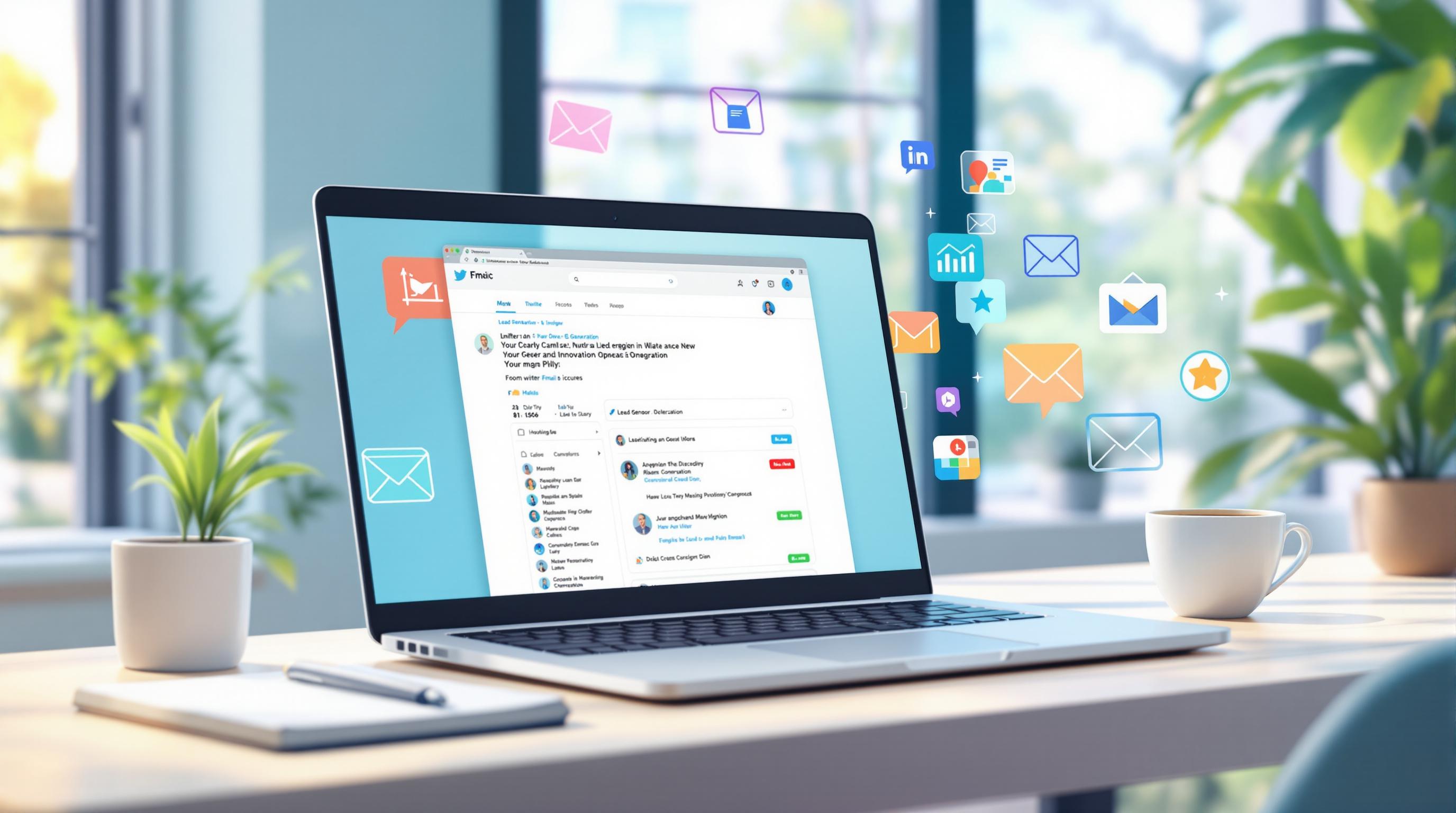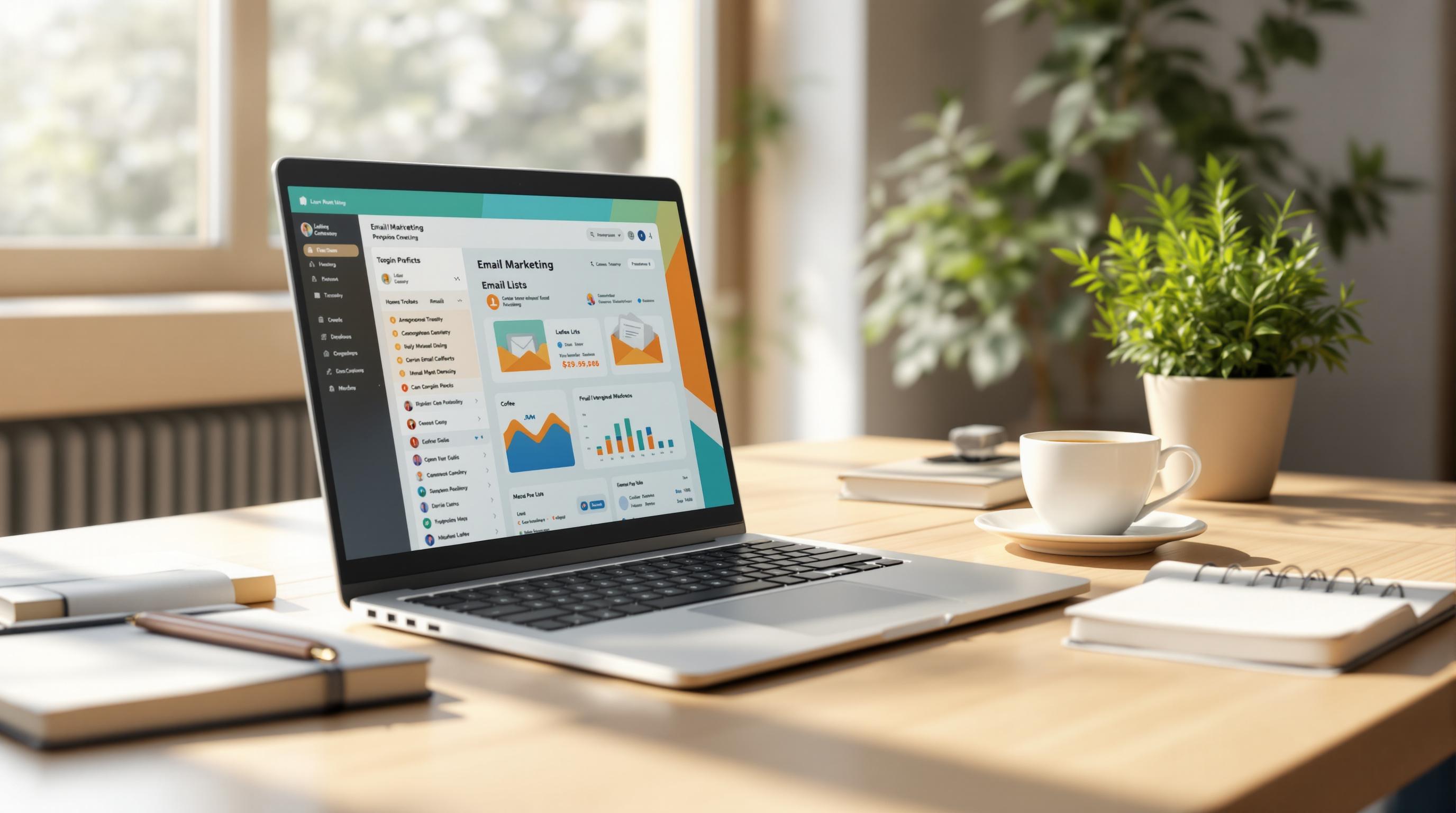Want to boost email marketing results? Drip campaigns can increase sales by 80% and drive 7x more revenue than standard emails. Here's how they work:
- What Are Drip Campaigns? Automated email sequences triggered by actions or time.
- Why Use Them? They nurture leads, keep engagement high, and improve conversions by 180%.
- When to Send Emails?
- B2B: 9-11 AM for best open rates, 1-2 PM for clicks.
- B2C: Evenings (5-6 PM) work best.
- How to Plan?
- Set clear goals (e.g., increase open rates by 20%).
- Segment audiences by behavior, demographics, or customer journey.
- Use triggers like website visits or inactivity to automate follow-ups.
- Key Results: Well-timed and personalized drip emails can boost revenue by 760% and achieve open rates of 29%.
Drip campaigns are all about sending the right email at the right time. Learn how to structure, automate, and optimize your campaigns for maximum impact.
Campaign Planning Steps
Before starting your drip campaign, taking the time to plan thoroughly can make all the difference. Research shows that well-structured drip campaigns can drive results, with segmented campaigns generating up to 760% more revenue [1].
Setting Goals
Define specific, measurable goals for your campaign. These should align with your broader marketing strategy and include clear metrics. For example, if engagement is your focus, you might aim to:
- Increase open rates by 20% within 90 days
- Reach a 41% click-through rate using personalized content
- Achieve a 29% conversion rate for targeted customer groups [1]
Once your objectives are set, you can design your campaign to resonate with different audience segments.
Audience Groups
Segmenting your audience is key to creating targeted and effective campaigns. Here are a few ways to group your audience and how to use those segments:
| Segment Type | Criteria | Example Use Case |
|---|---|---|
| Behavioral/Engagement | Past purchases, website activity, open or click rates | Re-engaging inactive users or targeting high-value customers |
| Demographics | Age, location, industry | Offering industry-specific solutions |
| Customer Journey Stage | New subscribers vs. long-term customers | Welcome emails or loyalty programs |
"Drip campaigns thrive on automation, so consider how to maximize efficiency beyond email scheduling." - ActiveCampaign [1]
After dividing your audience, the next step is to create a schedule that fits their preferences and behaviors.
Email Schedule Planning
The structure of your campaign will depend on your goals. For lead nurturing, a series of 5-7 emails spread over several weeks often works well [1][2]. When planning your schedule, consider these factors:
- Customer journey and engagement: Match your email sequence to key milestones in the customer journey, using past data to decide the best times to send.
- Industry norms: Take into account the typical sales cycle for your industry.
- Content complexity: If your product or service is more detailed, you may need longer gaps between emails to avoid overwhelming your audience.
The goal is to keep your audience engaged while avoiding email fatigue.
Creating Your Timeline
Planning a drip campaign timeline takes thought and precision. It involves aligning customer touchpoints, triggers, and content flow to create a seamless experience. Research shows that well-structured drip campaigns can see 70% higher open rates and 30% better click-through rates compared to regular email marketing [1].
Customer Journey Points
Your emails should align with key stages of the customer lifecycle:
| Journey Stage | Description |
|---|---|
| Welcome Phase | Day 0-7: Introduction and onboarding |
| Activation Phase | Day 7-14: Highlight features and share proof |
| Engagement Phase | Day 15-30: Offer exclusive content and build community |
| Retention Phase | Day 31+: Gather feedback and explore upsell opportunities |
Once you’ve mapped these stages, the next step is to set up triggers that activate your email sequences.
Email Triggers
Triggers are automated actions that send emails based on customer behavior or timelines. Common types include:
- Behavioral Triggers: Actions like website visits, downloading content, or viewing product pages.
- Time-Based Triggers: Events like subscription anniversaries or seasonal campaigns.
- Engagement Triggers: Metrics such as email opens, link clicks, or form completions.
- Inactivity Triggers: Examples include no login activity for 30 days or cart abandonment after 24 hours.
For example, if a user cancels their subscription, you can send a win-back email with personalized content to re-engage them.
Email Flow Structure
Your email sequence should guide recipients through each stage of their journey. Start with a welcome email that highlights key benefits and sets clear expectations. Follow up with content that addresses their needs or challenges, and end with a strong call-to-action. Emails with a single, clear CTA have been shown to boost clicks by 371% [1].
Running and Improving Campaigns
Email marketing platforms make running campaigns easier with their automation tools. Studies show that well-tested drip campaigns can boost both engagement and conversions [1].
Automation Setup
Key automation features for running effective campaigns include:
- Start Triggers & Action Rules: These kick off and guide the sequence based on user behavior.
- Time Delays: Space out messages (e.g., every 3 days) to avoid overwhelming recipients.
- Goal Tracking: Track metrics like conversions to measure success.
Platforms like Campaign Monitor and MailChimp provide these tools, with pricing starting at $9-$15 per month [1].
Timeline Testing
Testing is essential to fine-tune your drip campaigns. You can adjust and measure the effectiveness of various elements, such as:
- Email Timing: Experiment with different send times and intervals to identify the best engagement patterns.
- Content Variations: Test subject lines, message length, and calls-to-action while keeping a control version for comparison.
- Sequence Flow: Optimize the order of emails and evaluate how well trigger conditions work.
By identifying what works best, you can continuously improve your campaigns for better results.
Performance Tracking
Once your campaign is live and tested, tracking performance metrics ensures you stay on the right path. Focus on:
- Engagement Metrics: Open rates, click-through rates, and overall interaction with your emails.
- Conversion Tracking: Monitor goal completions and the revenue generated.
- List Health: Keep an eye on bounce rates and unsubscribes to maintain a strong email list.
- Campaign Flow: Identify where users drop off in the sequence to address weak points.
Daniel Foley Carter emphasizes that "drip campaigns guide customers to take action, even if they miss the initial email."
Industry standards suggest a click rate of 15% or higher for successful campaigns [1]. Use these insights to refine your strategy and get the most out of your efforts.
sbb-itb-8abf799
Timeline Tips and Guidelines
HubSpot's research shows that sending 4-7 emails per month usually results in better open and click-through rates compared to sending too many or too few.
Finding the Right Email Frequency
Different industries benefit from varying email frequencies. Here's a quick reference:
| Industry | Monthly Email Range | Best Days to Send | Average Open Rate |
|---|---|---|---|
| B2B Services | 4-6 emails | Tuesday-Thursday | 21.33% |
| E-commerce | 6-8 emails | Friday-Sunday | 18.90% |
| SaaS | 3-5 emails | Monday-Wednesday | 25.00% |
To keep your audience engaged:
- Set clear expectations during signup and let subscribers adjust preferences through a preference center.
- Test email frequencies on smaller groups before rolling out changes to your entire list.
Frequency matters, but timing emails based on user behavior can drive even better results.
Timing Emails Around Behavior
Marketo's case studies reveal that behavior-based emails can increase engagement by 25%. Tools like ActiveCampaign and Mailchimp make it easier to send emails triggered by user actions.
"ActiveCampaign emphasizes aligning marketing messages with customer behavior across preferred channels for better engagement."
Use behavioral data - like email opens, website visits, or purchase history - to decide when to send follow-ups. This approach ensures your emails feel timely and relevant.
Connecting Channels for Better Results
Combining email with other platforms helps create a seamless customer experience. For example, pairing social media ads with follow-up emails can strengthen your messaging.
Here are some tips for integrating channels:
- Keep your branding consistent across platforms.
- Use social media engagement data to fine-tune email timing.
- Promote email subscriptions through content marketing efforts.
- Monitor cross-channel metrics to improve overall performance.
Using Email Extractor Tool - Extract Emails with AI Automation

The Email Extractor Tool uses AI to find and extract valid email addresses from web pages, simplifying the process of preparing drip campaigns. It works seamlessly through a Chrome extension for easy access.
Tool Overview
This tool combines AI-driven email detection with features designed to make list building straightforward:
| Feature | How It Helps with Drip Campaigns |
|---|---|
| AI-Powered Detection | Quickly finds valid email addresses on web pages. |
| Chrome Extension | Access directly while browsing target sites. |
| Batch Processing | Extract emails from multiple pages at once. |
| CSV/TXT Export | Easily upload lists to email marketing platforms. |
"Marketing teams using the Email Extractor Tool have reported a 30% increase in lead generation and 20% improvement in conversion rates through more targeted drip campaigns."
Pricing Options
| Plan | Monthly Price | Email Volume | Best For |
|---|---|---|---|
| Starter | $8.99 | 5,000 emails | Small businesses new to drip campaigns. |
| Growth | $37.99 | 50,000 emails | Mid-sized companies running regular campaigns. |
| Enterprise | $139.99 | 1,000,000 emails | Large-scale, high-volume campaigns. |
All plans include essential features like AI automation and CSV exporting, scaling to meet your campaign needs.
These email lists integrate effortlessly with your campaign strategies, helping you fine-tune audience segmentation and schedule messages for better results.
Summary
Key Takeaways
Creating a successful drip campaign requires careful planning, smart automation, and ongoing adjustments. According to research from ActiveCampaign, well-designed drip campaigns can achieve conversion rates of up to 5% for new trial users when executed effectively [1]. Here’s a quick breakdown of the three essential components:
| Component | Key Focus | Role in Success |
|---|---|---|
| Planning | Segmentation & Goals | Ensures content is targeted and relevant |
| Execution | Automation & Triggers | Delivers timely, consistent messaging |
| Optimization | Testing & Tracking | Fine-tunes the campaign for better results |
Once these core elements are in place, you can elevate your campaign's effectiveness by applying specific strategies.
Tips for Success
To get the most out of your drip campaigns, consider these strategies:
- Find the Right Timing and Frequency: Understand your audience’s habits and tailor message timing to match their engagement patterns. This keeps your communication relevant and avoids overwhelming them [1].
- Leverage Automation: Automate lead transitions between campaigns based on their interactions. This ensures follow-ups are timely and content stays relevant without needing constant manual updates.
- Track and Adjust Performance: Regularly review key metrics like open rates, click-through rates, and conversions. Use these insights to tweak your campaign’s structure and timing for better results.



